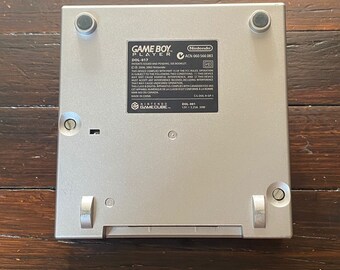
- #USED NINTENDO GAMECUBE WITH GAMEBOY PLAYER MOVIE#
- #USED NINTENDO GAMECUBE WITH GAMEBOY PLAYER LICENSE#
Up to four Game Boy Advance systems can be connected to the GameCube through the GameCube's four controller ports for multiplayer play. This functionality has been used to unlock bonuses such as new levels or characters when certain Game Boy Advance and GameCube games are connected together. Information related to game play may be displayed on the Game Boy Advance's color screen for added convenience or to avoid the cluttering of the display on the television screen. Examples of this functionality include the use of the Game Boy Advance as a controller for the game played. The GameCube can also connect to a Game Boy Micro, but the cable required to connect the two must be custom made since it has not been otherwise made available. The GameCube can connect to a Game Boy Advance or Game Boy Advance SP to transfer game data. However, the Panasonic Q Game Boy Player was released to address the problem of the extended pegs on the bottom, allowing play of Game Boy games.


Differences in design make the Panasonic Q incompatible with the Game Boy Player. It was never released outside of Japan production ceased in December 2003.
#USED NINTENDO GAMECUBE WITH GAMEBOY PLAYER LICENSE#
The Panasonic Q, released by Panasonic in Japan under license from Nintendo, is manufactured as a modified GameCube unit with added DVD and audio CD playback functionality. Despite the protection of a non-standard disc format (essentially a miniature DVD-ROM with non-standard sectors and filesystem formatting), a number of modchips such as the Qoob and ViperGC have been released that, when used in conjunction with a modified BIOS, allow the use of a standard or 8 cm DVD-R to load backed-up, homebrew, bootleg or copied software. A number of games with large amounts of audio or video were scaled down when ported to the GameCube.
#USED NINTENDO GAMECUBE WITH GAMEBOY PLAYER MOVIE#
The lack of DVD movie support was a double-edged sword it did not appeal to the mass audience that turned to the PlayStation 2 and Xbox due to their built-in DVD support. Common reasons cited by Nintendo for using this format are to reduce copyright infringement, provide faster loading times, make the system cheaper by avoiding DVD-licensing fees, and allow smaller discs. The Nintendo GameCube does not have DVD or audio CD support, but Matsushita's Panasonic Q (described below), only available in Japan, does. By exploiting a flaw in Phantasy Star Online Episode I & II, users were able to connect their GameCubes to their PCs and run homebrew programming on the console. This move was intended to prevent unauthorized copying of GCN titles, but was eventually cracked. Contrary to popular belief, GameCube discs are not physically read any differently from a standard DVD disc, but are encrypted with a key derived from the Burst Cutting Area, a 'bar code' unreadable by most DVD drives. The Nintendo GameCube uses a proprietary storage medium, the Nintendo GameCube Game Disc, based on Matsushita's optical-disc technology the discs are approximately 8 centimeters (3 1/8 inches) in diameter (considerably smaller than the 12 cm CDs or DVDs used in competitors' consoles), and have a capacity of approximately 1.5 gigabytes. In Japan, the system is also available in Spice (orange), or in limited edition colors like Crystal White, Mint Green, Copper, and White with black pinstripes.


Shaped roughly like a cube, the console is available in a variety of colors, such as indigo, platinum, and black (also a limited edition Resident Evil 4 platinum and black game console). The GameCube was unveiled on 24 August 2000, one day before Nintendo's SpaceWorld trade show. In late 2006, it was superseded by the Wii. The GameCube was released on Septemin Japan Novemin North America in Europe and in Australia. The GameCube itself is the most compact and least expensive of the sixth generation era consoles. The Nintendo GameCube ( ニンテンドーゲームキューブ, Nintendō GēmuKyūbu ?, GCN) is Nintendo's fourth home video game console, belonging to the sixth generation era. Commercial failures in computer and video gaming


 0 kommentar(er)
0 kommentar(er)
